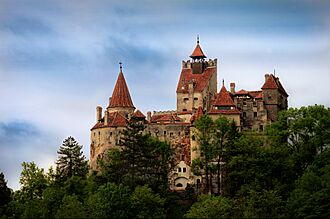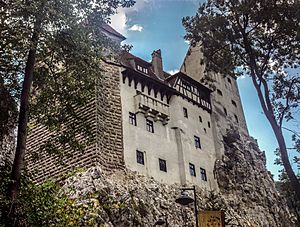Bran Castle facts for kids
Quick facts for kids Bran Castle |
|
|---|---|

Bran Castle
|
|
| Alternative names | Dracula's Castle |
| General information | |
| Type | Castle |
| Architectural style | Medieval |
| Location | Bran, near Brașov, Transylvania |
| Address | 24, Gen. Traian Moșoiu St. |
| Country | Romania |
| Coordinates | 45°30′54″N 25°22′02″E / 45.51500°N 25.36722°E |
| Elevation | 2,500 feet (760 m) |
| Owner | Archduke Dominic of Austria-Tuscany |
Bran Castle (called Castelul Bran in Romanian) is a famous castle in a town called Bran, about 25 kilometers (15 miles) southwest of Brașov in Romania. It was built by German settlers, known as Saxons, in 1377. They received permission from King Louis I of Hungary to build it.
This castle is a very important national landmark in the region of Transylvania. It stands on the border between Transylvania and another historical region called Wallachia.
Many people outside Romania know Bran Castle as Dracula's Castle. It is often presented as the home of the fictional character Count Dracula from Bram Stoker's famous novel Dracula. However, there is no proof that Stoker ever knew about this castle. The castle has only a small connection to a real ruler named Vlad the Impaler, who was a prince (or voivode) of Wallachia. His nickname 'Drăculea' sounds similar to Dracula. Also, Stoker's description of Dracula's old, crumbling castle does not look like Bran Castle at all.
Today, Bran Castle is a museum. It shows off art and furniture that belonged to Queen Marie. Visitors can explore the castle on their own or take a guided tour. At the bottom of the hill, there is a small open-air museum. It displays old Romanian peasant buildings like cottages, barns, and water mills from the Bran area.
Contents
History of Bran Castle
Early Wooden Castle
In 1212, a group of knights called the Teutonic Order built a wooden castle named Dietrichstein. It was a strong point in the Burzenland region, guarding a mountain pass. Traders had used this pass for over a thousand years. This first wooden castle was destroyed in 1242 during the Mongol invasion.
The name Dietrichstein, or lapis Theoderici in Latin, means "Dietrich's Stone." It likely came from a commander of the Teutonic Order named frater Theodericus, who was probably the one who built the castle.
Building the Stone Castle
The first official mention of Bran Castle as we know it was on November 19, 1377. King Louis I of Hungary gave the German settlers of Kronstadt (now Brașov) permission to build a stone castle. They had to pay for it and build it themselves. A town then started to grow around the castle.
From 1438 to 1442, the castle was used to defend against the Ottoman Empire. Later, it became a customs post. This meant that people had to pay taxes on goods when they passed through the mountain path between Transylvania and Wallachia.
Many castles back then belonged to rich nobles. But Bran Castle was built mainly to protect the German settlers in Transylvania. It is thought that Mircea the Elder, a ruler of Wallachia, briefly controlled the castle around 1386–1418. He was the one who set up the customs point.
Vlad the Impaler (who ruled from 1448 to 1476) did not play a big part in the castle's history. Even though he passed through the Bran Gorge several times, he did not live there.
At one point, Bran Castle belonged to the Hungarian kings. But King Vladislaus II of Hungary could not pay back his loans. So, in 1533, the city of Brașov got the castle back.
In 1530, Moise of Wallachia, a prince of Wallachia, tried to capture the castle with his army. But soldiers from the Székely people, led by the castle lord Dénes, defended it. The Wallachian army had to leave. Bran Castle was important for military defense until the mid-1700s.
A Royal Home
After World War I, in 1920, the Treaty of Trianon changed the borders of Hungary. Transylvania became part of the Kingdom of Romania. The German settlers of Brașov gave Bran Castle to the Romanian royal family. They no longer needed it and could not afford to fix it up.
The castle became a favorite home for Queen Marie. She loved it and ordered many repairs and changes. A Czech architect named Karel Zdeněk Líman oversaw this work. Queen Marie's daughter, Princess Ileana, inherited the castle. She even ran a hospital there during World War II.
In 1948, the communist government took over Romania and forced the royal family to leave. The castle was then taken by the state.
Returning to the Family
In 2005, the Romanian government passed a law to return properties that had been taken illegally. A year later, in 2006, the ownership of Bran Castle was given back to Archduke Dominic of Austria. He is the son of Princess Ileana.
On May 18, 2009, the government officially handed over the management of Bran Castle to Archduke Dominic and his sisters. On June 1, 2009, the Habsburg family opened the castle to the public. It became the first private museum in Romania. They worked with the village of Bran to keep the castle important for tourism and help the local economy.
Bran Castle and Dracula
Many stories connect Bran Castle to the Dracula myth. However, most historians agree that Vlad the Impaler, also known as Vlad III Dracula, never lived in Bran Castle. It was not a friendly place for him, and it was not under his control. People once thought he was held prisoner there in 1462. But historians now believe he was imprisoned in a fortress in Budapest.
The Book Dracula
Bran Castle is not mentioned in Bram Stoker's novel Dracula. There is no proof that Stoker ever visited Transylvania or Bran Castle. Also, the castle described in the book does not look like Bran Castle. The idea that Bran Castle is "Dracula's Castle" is mainly used to attract tourists.
When Stoker was researching Transylvania for his book, he learned about the terrible things Vlad III did. He used the name Dracula after reading about him. But Vlad III was not the only inspiration for the Dracula character. It is mostly because of American movies that Vlad III is now seen as the main inspiration for Dracula.
See also
 In Spanish: Castillo de Bran para niños
In Spanish: Castillo de Bran para niños
- Castles in Romania
- Poenari Castle, a real castle ruin connected to Vlad the Impaler
- Peleș Castle
- Corvin Castle
- Tourism in Romania
- Seven Wonders of Romania


